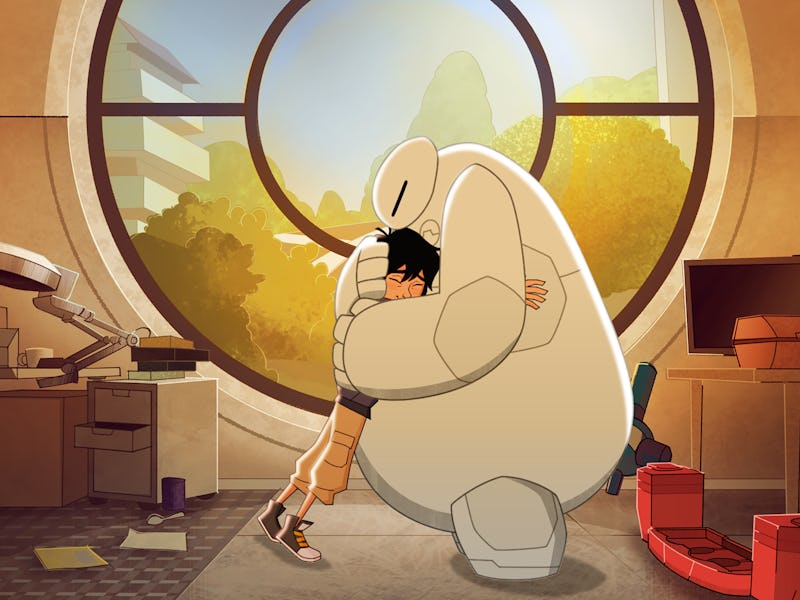A "human-scale soft robot" could make deliveries in a quarantine
Just don't expect it to do it quickly.

Picture this: While disaster workers and medical staff are hard at work trying to cull the COVID-19 pandemic, a team of brightly colored, air-filled robots is diligently transporting food and medical equipment to hospitals that need it most.
Engineers and scientists have toiled for years over how to design strong, independent and flexible robots that can help human beings survive and navigate some of the universe's harshest domains. But most models have either been tied down by power cables or too bulky to squeeze into small spaces.
Now, instead of going leaner and meaner, a team of roboticists from Stanford and UC Santa Barbara have decided to solve these various problems by going softer and squishier in the form of a soft robot made from air-filled nylon tubes and electric motors.
While we've become accustomed to seeing robots with blinking eyes and smiling faces, this team's robot is decidedly less human-like. The first author on the paper and graduate student in mechanical engineering at Stanford, Nathan Usevitch, said in a statement that doesn't stop the robot from being endearing nonetheless.
"The casual description of this robot that I give to people is Baymax from the movie Big Hero 6 mixed with Transformers. In other words, a soft, human-safe robot mixed with robots that can dramatically change their shape," said Usevitch
This human-sized soft robot is designed to squeeze into hard to reach places that would be too dangerous for humans to go.
And this robot's otherworldly appearance is not without purpose, write the authors in a paper published Wednesday in the journal Science Robotics -- there are a few key differences that set their design apart from the rest. First, to design a robot that can be truly useful to humans in a dynamic environment, they knew they had to design a robot that could be free of any tethers or power cables. In their research, this meant designing a pneumatic robot that only had to be pumped full of air once before use.
In both their smaller 2D design and larger, human-sized 3D design, the robots were made of interconnected triangles with motorized nodes at each point. This allowed for a second key innovation: unassisted movement. This was achieved by moving the robot's motorized nodes along its arms to create a change in shape. Like its adorable slow-motion fall as seen in the video below.
The authors write that this bot's ability to change shape without changing the overall pressure or length of its arms makes it something called an "isoperimetric robot."
Elliot Hawkes, assistant professor of mechanical engineering at the UC Santa Barbara and co-senior author of the paper, said in a statement that being isoperimetric makes their robot much quicker and more efficient than other models.
"A key understanding we developed was that to create motion with a large, soft pneumatic robot, you don't actually need to pump air in and out," said Hawkes. "You can use the air you already have and just move it around with these simple motors; this method is more efficient and lets our robot move much more quickly."
The authors also found that this structure still allowed their robot to withstand obstacles (in their case, trying to push the robot over) without sacrificing flexibility. These complementary characteristics could help make this bot successful not only on Earth but when exploring extraterrestrial worlds as well.
THE INVERSE ANALYSIS
As things stand right now, the robot is not yet fast or strong enough to fulfill some of these promises -- but we shouldn't hold that against it. As researchers continue to develop this we think its self-contained design will make it incredibly effective either as a rescue worker on Earth or a new kind of Martian rover.
Abstract: For robots to be useful for real-world applications, they must be safe around humans, be adaptable to their environment, and operate in an untethered manner. Soft robots could potentially meet these requirements; however, existing soft robotic architectures are limited by their ability to scale to human sizes and operate at these scales without a tether to transmit power or pressurized air from an external source. Here, we report an untethered, inflated robotic truss, composed of thin-walled inflatable tubes, capable of shape change by continuously relocating its joints, while its total edge length remains constant. Specifically, a set of identical roller modules each pinch the tube to create an effective joint that separates two edges, and modules can be connected to form complex structures. Driving a roller module along a tube changes the overall shape, lengthening one edge and shortening another, while the total edge length and hence fluid volume remain constant. This isoperimetric behavior allows the robot to operate without compressing air or requiring a tether. Our concept brings together advantages from three distinct types of robots—soft, collective, and truss-based—while overcoming certain limitations of each. Our robots are robust and safe, like soft robots, but not limited by a tether; are modular, like collective robots, but not limited by complex subunits; and are shape-changing, like truss robots, but not limited by rigid linear actuators. We demonstrate two-dimensional (2D) robots capable of shape change and a human-scale 3D robot capable of punctuated rolling locomotion and manipulation, all constructed with the same modular rollers and operating without a tether.